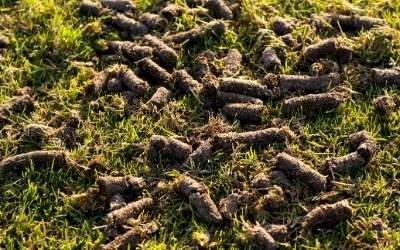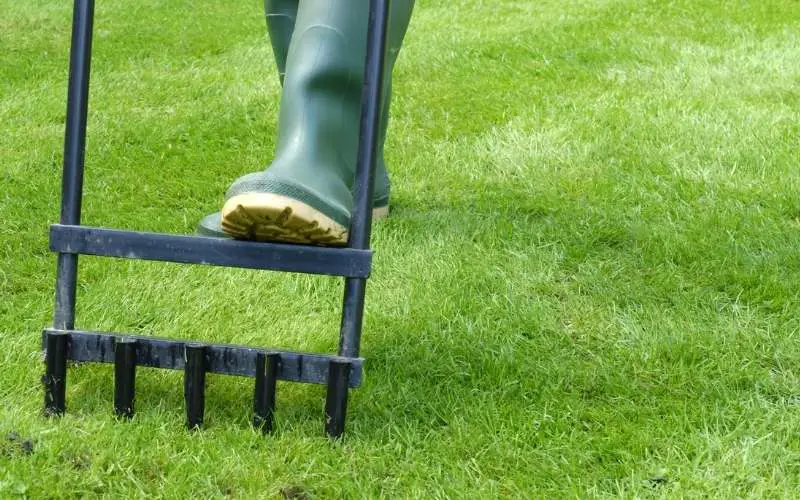Can I Aerate My Lawn if It’s Wet? (The Wet Grass Guide!)
The soil in your yard is not the same everywhere. Some parts are more compact than others, and some have a higher percentage of clay and silt. Sometimes you have to decide if you should aerate your own, even when it’s wet. This can affect the way that you aerate your lawn, but it doesn’t mean that you should skip this important step altogether!
There are many benefits to aerating your lawn regularly and even when it’s wet, like improving drainage and reducing weed pressure. So, it’s worth taking the time to understand if it’s the right time to do so and when to do so correctly.
Can you aerate a wet lawn?
Yes, aerating a wet lawn is definitely possible and can be beneficial, but it’s crucial to ensure the lawn is not excessively wet. Aerating is advised when the lawn is moist but not in a state where mud puddles form or where the soil is so saturated that you sink into it. Overly wet or waterlogged conditions can make aerating ineffective and potentially damage the lawn’s structure.
Regular aeration is key to achieving a healthy, evenly lush yard, as it allows air, water, and nutrients to penetrate the soil more effectively. The timing of aeration is important for optimal results. Using the appropriate tools and equipment designed for wet conditions can make the process easier and more effective. When done under the right conditions, aeration helps break up compacted soil, thereby promoting the lawn’s overall health and beauty.
Why is it important to aerate your lawn?
Aerating your lawn is crucial because it facilitates healthier, more vigorous grass growth. Grassroots predominantly grow in an upward direction and require air, water, and nutrients for their growth. Compact or dense soil can act as a barrier, hindering these vital substances from being absorbed by the roots, resulting in compromised grass growth.
Consequently, lawns can appear thin and contain dead patches where grass doesn’t grow at all. Aeration, which involves creating small holes in the soil surface, remedies this problem by allowing air, water, and nutrients to infiltrate the soil more effectively. These holes also provide space for the grassroots to expand and establish a robust root system, enhancing their ability to absorb nutrients and water.
As a result, there is a fair distribution of nutrients and water, contributing to a healthier and more uniform lawn. Without aeration, compacted soils can starve the grass of its basic needs, leading to unevenly coloured and growing grass across your yard. Thus, routine aeration is integral to a lush, thriving lawn.
How does wet soil affect the way you aerate your lawn?
1. Soil Type
Understanding the soil type in your lawn is essential for effective aeration, especially when the soil is wet. Different types of soil components, particularly minerals and organic matter, influence water retention. For instance, clay-rich soils are known for their ability to absorb and retain moisture, which can significantly impact the aeration process. When aerating wet clay soil, it’s crucial to wait until it’s moist but not saturated to prevent compacting it further. In contrast, sandy soil with less water retention may allow for more flexibility in aeration timing after rainfall. Acknowledging your soil type helps devise a more strategic aeration schedule, ensuring better oxygen, water, and nutrient flow to your grass roots without damaging the soil structure.
2. Thatch
Thatch, the layer of organic matter consisting of dead grass, roots, and debris, can significantly influence aeration, especially in wet conditions. A thick thatch layer can absorb and trap moisture, creating a barrier that prevents water and air from penetrating the soil effectively. When aerating a lawn with a wet thatch layer, it is beneficial to consider dethatching as a preparatory step. This process involves removing some of the thatch to ensure that the aeration process is more effective, allowing for improved soil access. Addressing thatch before aerating can lead to a healthier, more breathable lawn environment that encourages deeper root growth and nutrient uptake.
3. Seasonality
The seasonal preferences of your grass type play a pivotal role in determining the optimal time for aeration, particularly under wet conditions. Different grass types thrive in varying seasons; cool-season grasses may benefit from fall aeration, while warm-season grasses might prefer late spring or early summer. Wet soil, resulting from seasonal rains or thawing snow, requires careful consideration. Aerate when your grass type is most actively growing and when the soil is moist but not overly wet to avoid compaction. This strategic timing ensures that the grass can recover quickly from the stress of aeration and take full advantage of the improved air, water, and nutrient flow during its peak growth phase.
4. Dry versus Humid Climates
The impact of your local climate—whether predominantly dry or humid—on soil moisture levels cannot be overstated, particularly when planning lawn aeration. In humid climates, lawns may experience prolonged soil moisture, necessitating a careful approach to aeration to prevent soil compaction. On the other hand, in dry climates, soils might absorb water too quickly, making it challenging to find the right moisture balance for efficient aeration. Understanding the typical climate patterns of your area can help in scheduling aeration at times when the soil has the ideal moisture content—neither too dry nor too soggy. This balance is crucial for facilitating the infiltration of air and water into the soil, promoting healthier lawn growth.
When should you aerate your lawn after the rain?
It’s optimal to aerate your lawn after the rain when the soil is moist but not waterlogged. Citing guidance from Briggs and Stratton, it’s advisable to wait about 24 hours after a rainfall before performing aeration. This pause allows excess water to drain and the soil to reach a favorable moisture level that facilitates easier penetration of aeration tools, enabling you to create deeper and more effective holes for the roots to breathe and grow.
The morning hours, renowned for lower temperatures and higher humidity, can offer the ideal conditions to keep the soil suitably moist during the process. However, it’s important to be mindful not to aerate when there’s standing water from heavy rain, as this can cause further soil compaction and potentially damage the turf.
Similarly, trying to aerate overly dry soil can be counterproductive, as it can lead to further compaction and damage the lawn. Observing these timing and condition guidelines will help ensure that aeration is both effective and beneficial for the lawn’s health and appearance.
When is it too wet to aerate your lawn?
- Presence of Puddles on the Lawn: Lingering puddles are clear indicators of waterlogged soil. After substantial rainfall, if these pools of water remain scattered across your lawn and don’t dissipate within a reasonable timeframe, the soil beneath is too saturated for effective aeration. In this scenario, patience is key; allow time for the water to naturally absorb into the soil or evaporate.
- Aeration Holes Rapidly Filling with Water: Should you attempt preliminary aeration and observe that the freshly made holes are quickly filling with water, this is an overt sign that the soil retains too much moisture. Such conditions are not conducive to successful aeration because the waterlogged holes negate the process’s purpose by restricting air flow to the roots.
- Immediate Closure of Aeration Holes: Observing the soil swiftly collapsing and sealing the aeration holes soon after they are made indicates excessive wetness in the soil. The immediate recompaction of these holes suggests that the soil lacks the structural integrity to remain open due to its saturated state, rendering the aeration process futile until the soil dries to a more conducive level.
- Formation of Compact Clots from Hollow Aerator: Utilizing a hollow aerator that yields soft, shapeless clods of soil instead of firm, moist cylindrical plugs illustrates too much moisture in the lawn. A properly executed aeration should produce plugs that retain their shape, indicating the correct moisture balance. Soft, liquified clods that lack form denote an overly wet lawn, suggesting that aeration at this time would be ineffective and potentially damaging to the soil structure.

What to do after aerating a wet lawn
After aerating a wet but not overly saturated lawn, there are some significantly beneficial steps you can take to invigorate your yard’s health and appearance. Following aeration, while aeration holes are fresh and direct access to the root zone is available, attempts to reseed and fertilize are highly recommended. The ready absorption of seeds and nutrients deeply into the soil that aeration facilitates presents a unique opportunity to assist new growth and support already established growth simultaneously.
The aeration holes, at this stage, act as perfect conduits for seeds to settle and nutrients to disperse, enabling you to efficiently establish a thick, lustrous lawn. Fertilizing will replenish nutrients lost through the aeration process and help the existing grass to thrive, while reseeding will aid in filling any thin or bare areas, improving the lawn’s overall density and lushness.
Remember, the key to a successful aeration process lies in the appropriate timing, ideally about 24 hours after rainfall, when the soil is moist but not waterlogged. Performing aeration under these conditions assures consistent and effective holes, which subsequently boost the effects of reseeding and fertilizing post-aeration.
How to get your lawn to dry faster
- Use of Horticultural Sand: As you mentioned, horticultural sand is a practical tool for accelerating the drying process. It aids in the improvement of soil drainage, allowing waterlogged areas to dissipate more quickly. A light, even layer of this sand over the affected areas can significantly enhance overall drainage. Keep in mind, however, it’s vital to avoid applying an excessively thick layer of sand as this might work against you by creating a sand layer too compact for water to seep through, consequently exacerbating the waterlogged conditions.
- Promote Evaporation with Lawn Rolling: Another method to expedite the drying process involves a lawn roller. By gently rolling the waterlogged areas, you essentially press the residual water upwards towards the grass surface, efficiently promoting evaporation. This method is mainly dependent upon weather conditions; brighter, sunnier climates will, of course, result in faster evaporation rates.
- Increase Sunlight Exposure: Trimming overgrown trees and shrubs surrounding your lawn can allow more sunlight to reach your waterlogged grass. An increased sunlight exposure can help speed up the evaporation process, drying up your wet lawn more quickly. Remember, a healthy balance is key — while sunlight aids in drying, too much sunlight can also be detrimental, causing grass to dry out excessively and possibly scorch.
- Improve Soil Aeration: While it may seem counterintuitive to discuss aeration while dealing with a wet lawn, enhancing aeration can actually improve the soil’s drainage capacity in the long term. However, this method should be employed under suitable conditions — when the lawn is damp but not waterlogged. Correctly spaced aeration holes allow the soil to breathe, assist in better water penetration, and prevent surface waterlogging in future.
- Consider a French Drain System: If your lawn consistently struggles with water retention, you might want to consider installing a French drain system. A French drain is a slightly sloped trench filled with round gravel and a pipe that diverts the water away from your house and yard. While this option might require significant work and potentially professional help, it can make a big difference in dealing with a perpetually soggy yard.
My final thoughts
Aerating a lawn that is wet is not a bad idea as long as it’s not too wet.
Aerating a lawn that is too wet may not always be the best idea because if there is too much moisture, you’ll have trouble getting all of those holes to stay open and free from waterlogging. However, when done correctly, aeration helps improve soil health which will, in turn, make for healthier grass.
Other interesting articles:
